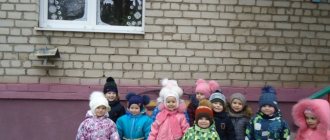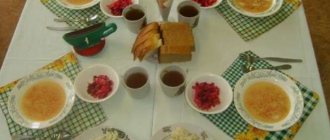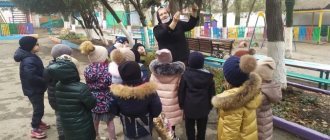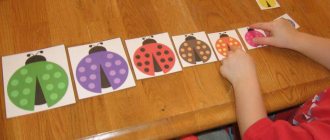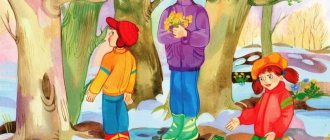Organization and methodology of a walk in kindergarten article on the topic
The importance of walking in the development of preschool children.
Children's stay in the fresh air is of great importance for the physical development of a preschooler. Walking is the first and most accessible means of hardening a child’s body. It helps to increase its endurance and resistance to adverse environmental influences, especially colds.
During the walk, children play and move a lot. Movement increases metabolism, blood circulation, gas exchange, and improves appetite. Children learn to overcome various obstacles, become more agile, dexterous, courageous, and resilient. They develop motor skills and abilities, strengthen the muscular system, and increase vitality.
A walk promotes mental development, as children gain a lot of new impressions and knowledge about the world around them.
Requirements for the duration of the walk. Duration of outdoor walks.
The daily routine of the kindergarten provides for a daily daytime walk after classes and an evening walk after afternoon tea. The time allotted for walking must be strictly observed. Its total duration is 4 – 4.5 hours.
— To achieve a healing effect in the summer, the daily routine provides for children to spend maximum time in the fresh air with breaks for meals and sleep.
— In winter, outdoor walks are carried out 2 times a day: in the first half of the day - before lunch, in the second half of the day - before the children go home. In order to prevent hypothermia of body parts (face, arms, legs) in cold weather, it is recommended to send children to a heated vestibule for heating for no more than 5-7 minutes. Winter walks in kindergarten for children under 4 years old are held at temperatures down to -15°C, for children 5-7 years old at temperatures down to -20°C.
-The time for each age group to go for a walk is determined by the mode of education and training. Walking is prohibited due to wind force exceeding 15 m/s.
Requirements for the equipment and sanitary condition of the kindergarten area for walks.
To achieve the objectives of the comprehensive development of children, a landscaped area, planned and equipped in accordance with pedagogical and hygienic requirements, is of great importance. It is desirable that each age group has a separate area, fenced off from other groups by bushes. In this area, places are allocated for outdoor games and the development of children’s movements (flat area), for games with sand, water, building materials, for creative games and games with various toys.
The area should have equipment for developing movements: climbing fences (triangular, tetrahedral and hexagonal), a balance beam, a slide, equipment for jumping and throwing exercises. All this should have an attractive appearance, be durable, well processed, secured and suitable for the age and strength of the children. In addition to permanent equipment, toys and aids are brought to the site in accordance with the planned work plan. Playgrounds end with paths along which children can ride bicycles and scooters.
In addition to playgrounds, the site must have closed gazebos for protection from rain and sun. In dry and hot weather, watering the area and sand is done at least 2 times a day. Cleaning of the territory of the site is carried out by teachers, assistant teachers and junior teachers, and a janitor every day: in the morning before the children arrive and as the territory gets dirty. At the entrance to the building there should be gratings, scrapers, mats, and brushes. In winter, a slide, ice paths and snow structures, and a skating rink (if conditions permit) should be installed on the site.
Preparing for a walk.
Before going out for a walk, the teacher organizes hygiene procedures with the children: cleaning the nose, visiting the toilet.
Dressing children should be organized so as not to waste a lot of time and so that they do not have to wait for each other for a long time. To do this, it is necessary to think through and create appropriate conditions. Each group needs a spacious dressing room with individual lockers and a sufficient number of banquettes, chairs or benches so that the child can sit comfortably, put on leggings or shoes and not disturb other children.
Dressing and undressing children when preparing for and returning from a walk is necessary in subgroups:
- the teacher takes the first subgroup of children to the reception room to get dressed, which includes children who dress slowly and children with low self-care skills;
— the assistant teacher carries out hygiene procedures with the second subgroup and takes the children to the reception area;
- the teacher goes out with the first subgroup of children for a walk, and the assistant teacher finishes dressing the second subgroup and escorts the children to the teacher’s station;
— children with poor health are recommended to be dressed and taken outside with the second subgroup, and started from a walk with the first subgroup.
The teacher must teach children to dress and undress independently and in a certain sequence. First, they all put on leggings, shoes, then a scarf, coat, hat, scarf and mittens. When returning from a walk, undress in the reverse order. The nanny helps dress the kids, but gives them the opportunity to do what they can on their own. When children develop the skills of dressing and undressing, they will do it quickly and carefully; the teacher only helps them in individual cases (fasten a button, tie a scarf, etc.). We need to teach kids to help each other and not forget to thank each other for the service rendered. In order for dressing and undressing skills to develop faster, parents should provide their children with more independence at home.
In the summer, after children return from a walk, it is necessary to organize a hygiene procedure - washing their feet.
Requirements for children's clothing:
- at any time of the year, clothing and shoes must be appropriate for the current weather and should not contribute to overheating or hypothermia in children;
The order of storing clothes in the locker: put a hat and scarf on the top shelf. A jacket, leggings, tights, warm pants, outerwear are hung on a hook. Mittens with elastic should be pulled over the sleeves and outerwear hanger. Shoes are placed on the bottom shelf, socks are placed on top.
When going for a walk, children themselves bring out toys and materials for games and outdoor activities.
Keeping children out for a walk depends on the time of year, weather, previous activities, interests and age.
To ensure that children are willing to go for a walk, the teacher thinks through its content in advance and arouses children’s interest in it with the help of toys or a story about what they will be doing. If walks are meaningful and interesting, children, as a rule, go for walks with great desire.
Properly organized and thoughtful walks help to achieve the goals of the comprehensive development of children.
Walk structure:
1. Observation.
2. Outdoor games: 2-3 games of high mobility, 2-3 games of low and medium mobility, games of children’s choice, didactic games.
3. Individual work with children on the development of movements and physical qualities.
4. Children's labor on the site.
5. Independent play activity.
The sequence of structural components of a walk may vary depending on the type of previous activity. If the children were in an activity that required increased cognitive activity and mental stress, then at the beginning of the walk it is advisable to conduct outdoor games, jogging, and then observations. If there was a physical education or music lesson before the walk, the walk begins with observation or quiet play. Each of the required components of the walk lasts from 7 to 15 minutes and is carried out against the backdrop of children’s independent activity.
Observation.
A large part of the walks is devoted to observations (pre-planned) of natural phenomena and social life. Observations can be carried out with a whole group of children, with subgroups, as well as with individual children.
At a younger age, observations should take no more than 7-10 minutes and be bright and interesting; at an older age, observations should last from 15 to 25 minutes. They should be carried out daily, but each time children should be offered different objects to consider.
Objects of observation can be:
ü Wildlife: plants and animals;
ü Inanimate nature: seasonal changes and various natural phenomena (rain, snow, flowing streams);
ü Adult labor.
Observations of the work of adults (janitor, driver, builder, etc.) are organized 1-2 times a quarter.
Types of observation:
· Short-term observations are organized to formulate information about the properties and qualities of an object or phenomenon (children learn to distinguish shape, color, size, spatial arrangement of parts and the nature of the surface, and when familiarizing themselves with animals, characteristic movements, sounds made, etc.
· Long-term observations are organized to accumulate knowledge about the growth and development of plants and animals, and seasonal changes in nature. Children compare the observed state of the object with what was before.
When organizing observations, the teacher must always follow this sequence:
1. facts are established;
2. connections are formed between parts of the object;
3. children’s ideas are accumulating;
4. comparisons are made;
5. conclusions are drawn and connections are made between the observation being carried out now and those carried out earlier.
The surrounding life and nature provide an opportunity to organize interesting and varied observations.
Outdoor games.
The leading place during the walk is given to games, mainly active ones. They develop basic movements, relieve mental stress from classes, and develop moral qualities.
The choice of game depends on the time of year, weather, air temperature. On cold days, it is advisable to start your walk with games of greater mobility associated with running, throwing, and jumping. Fun and exciting games help children cope better with cold weather. In damp, rainy weather (especially in spring and autumn), sedentary games that do not require a lot of space should be organized.
Games with jumping, running, throwing, and balance exercises should also be carried out on warm spring, summer days and early autumn.
During walks, plotless folk games with objects, such as grandmothers, ring throws, skittles, can be widely used, and in older groups - elements of sports games: volleyball, basketball, gorodki, badminton, table tennis, football, hockey. In hot weather, water games are held.
Time for outdoor games and physical exercises during a morning walk: in junior groups - 6 - 10 minutes, in middle groups - 10-15 minutes, in senior and preparatory groups - 20-25 minutes. On an evening walk: in junior and middle groups – 10-15 minutes, in senior and preparatory groups – 12-15 minutes.
Every month, learn 2-3 exercises (repeat within a month and consolidate 3-4 times a year)
At a younger age, games with text (imitation of the teacher’s actions) are recommended.
In the middle group, the teacher distributes roles among the children (the role of the driver is performed by a child who can cope with this task).
In the senior and preparatory groups, relay races, sports games, and games with elements of competition are held.
Outdoor games end with walking or low-mobility play, which gradually reduces physical activity.
Children are not allowed to walk for long periods of time without moving. Children with reduced mobility and low initiative require special attention and should be involved in outdoor games.
During walks, the teacher conducts individual work with children: for some, he organizes a game with a ball, throwing at a target, for others - a balance exercise, for others - jumping from tree stumps, stepping over trees, running down hills.
Games with a high level of movement intensity should not be played at the end of the morning walk before leaving the site, as children in this case become overexcited, which negatively affects the nature of daytime sleep, increases the duration of falling asleep, and may cause a decrease in appetite.
In addition to outdoor games and individual exercises in basic movements, sports activities (exercises) are also organized during the walk. In the summer it’s cycling, hopscotch, in the winter it’s sledding, ice skating, sliding on ice paths, and skiing.
About half an hour before the end of the walk, the teacher organizes quiet games. Then the children collect toys and equipment. Before entering the room, they wipe their feet. Children undress quietly, without noise, carefully fold and put things in lockers. They change their shoes, put their suit and hair in order and go to the group.
Features of the organization of physical activity in winter:
- during the cold season, the teacher needs to ensure that children breathe through their noses. Nasal breathing corresponds to the development in children of the ability to breathe correctly and prevents nasopharyngeal disease;
- at low air temperatures, it is not advisable to organize games of high mobility, since they lead to forced breathing when children begin to breathe through their mouths. In these conditions, you should also not play games that require children to pronounce quatrains, refrains, or any text in a full voice.
Didactic games and exercises.
They are one of the structural components of the walk. They are short-lived, taking 3-4 minutes at a younger age, and 5-6 minutes at an older age.
Each didactic game consists of: a didactic task, content, rules, game situations.
When using d/games, the teacher must follow the pedagogical principles:
ü rely on the knowledge children already have;
ü the task should be quite difficult, but at the same time accessible to children;
ü gradually complicate the didactic task and game actions;
ü specifically and clearly explain the rules;
Types of didactic games:
· Playing with objects (toys or natural materials),
· Word games.
Various didactic exercises are a way to stimulate children's activity. They are carried out several times during one walk. A didactic exercise can be offered to children at the beginning, at the end, or can be woven into the course of observation, for example, “Bring a yellow leaf,” “Find a tree by leaf,” “Find a tree or shrub by description,” etc. They are carried out with the whole group or with part of it.
During walks, work is also done to develop the child’s speech: learning a nursery rhyme or a short poem, reinforcing a difficult sound to pronounce, etc. The teacher can recall with the children the words and melody of a song that they learned in a music lesson.
During independent play activities, children reflect the impressions received in the process of educational activities, excursions, everyday life, and acquire knowledge about the work of adults. This happens in the process of role-playing games.
The teacher encourages games with a family, astronauts, a steamship, a hospital, etc. He helps develop the plot of the game, select or create the necessary material for it. Interest in such (creative games) games develops in children from 3-4 years old. The heyday of role-playing play begins at the age of 4 and reaches its highest development in the middle of preschool age (5-6 years), and then is gradually replaced by games with rules that arise after the age of seven.
During the walk, the teacher makes sure that all the children are busy, not bored, and that no one gets cold or overheated. It attracts those children who run a lot to participate in quieter games.
Labor activity of children at the site.
Work activity while walking is of great educational importance. It is important that for each child the tasks are feasible, interesting and varied, and their duration does not exceed 5-19 minutes at a younger age and 15-20 minutes at an older age.
The forms of organizing children's labor are:
· Individual work assignments;
· Work in groups;
· Teamwork.
Individual work assignments are used in all age groups of kindergarten.
Collective work makes it possible to develop work skills and abilities simultaneously in all children in the group. During collective work, the ability to accept a common goal of work, coordinate one’s actions, and plan work together is formed.
In the younger group, children receive individual assignments consisting of one or two labor operations, for example, taking bird food and putting it in a feeder. The teacher takes turns involving all the children in feeding the birds. Or, for example, collecting pebbles for crafts. Work is organized as “work nearby”, while children do not experience any dependence on each other
In the middle group, two subgroups can work simultaneously and perform different work assignments; The teacher's constant attention to the quality of work is required;
showing and explaining the entire task - successive stages.
In older children, it is necessary to develop the ability to accept a work task, present the result of its implementation, determine the sequence of operations, select the necessary tools, and independently engage in work activities (with a little help from the teacher).
Individual assignments become lengthy, for example, collecting and decorating a herbarium.
About half an hour before the end of the walk, the teacher organizes quiet games. Then the children collect toys and equipment. Before entering the room, they wipe their feet. Children undress quietly, without noise, carefully fold and put things in lockers. They put on slippers, put their suit and hair in order and go to the group.
Targeted walks. The teacher organizes children’s observations of social life and natural phenomena outside the site. For this purpose, targeted walks are organized.
In the younger group, targeted walks are carried out once a week over a short distance, along the street where the kindergarten is located. With older children, such walks are carried out twice a week and over longer distances.
For children of the younger group, the teacher shows houses, transport, pedestrians, for the middle group - public buildings (school, House of Culture, theater, etc.). With older children, targeted walks are carried out to other streets, to the nearest park or forest. Children become familiar with the rules of behavior in public places and traffic rules.
On targeted walks, children receive many direct impressions of their surroundings, their horizons expand, their knowledge and understanding deepen, and their powers of observation and curiosity develop. Movement in the air has a positive effect on physical development. Walking for a long time during a walk requires children to have a certain amount of endurance, organization and endurance.
FGT to the structure of the main general education program of preschool education provides for the solution of program educational tasks not only within the framework of educational activities, but also during routine moments, such as a walk.
During the walk, it is possible to integrate various educational areas, such as “Physical Education”, “Health”, “Safety”, “Socialization”, “Cognition”, “Communication” and “Work”.
The tasks of the educational areas “Physical Education” and “Health” are solved during a walk during outdoor games with children and the development of basic movements and constitute one direction - physical development.
The tasks of the educational areas “Safety”, “Socialization”, “Labor” are solved during a walk during work assignments, familiarization with the work of adults, observations, independent play activities, didactic games with children and constitute one direction - social and personal development.
The tasks of the educational areas “Cognition” and “Communication” are solved during a walk through outdoor games with children, work assignments, familiarization with the work of adults, observations, experimentation with objects of the surrounding world, targeted walks, independent play activities, didactic games with children and constitute one direction – cognitive and speech development.
Meaningful connections between different sections of the program allow the educator to integrate educational content when solving educational problems. For example, by expanding children’s ideas about nature, the teacher cultivates in children a humane attitude towards living things, encourages aesthetic experiences associated with nature, solves problems of speech development, mastering relevant practical and cognitive skills, and teaches them to reflect impressions of nature in a variety of play activities.
An integrative approach to conducting walks makes it possible to develop in unity the cognitive, emotional and practical spheres of the child’s personality.
Safety requirements when organizing walks in the kindergarten area.
Before children go out for a walk, the teacher inspects the territory of the site for compliance with safety requirements in accordance with his job description.
Before going out for a walk, Institution workers involved in dressing children must ensure that children do not remain dressed indoors for a long time in order to avoid overheating. Monitor the serviceability and compliance of children’s clothing and footwear with the microclimate and weather conditions.
If the wind increases to unacceptable levels or weather conditions worsen (rain, snowstorm, etc.) during a walk, the teacher must immediately bring the children indoors.
During the walk, the teacher makes sure that the children do not leave the kindergarten grounds. In the event of a child’s unauthorized departure, immediately report the incident to the head of the preschool educational institution, who organizes the search for the child, notifies the Department of Education, the police, and parents in accordance with the notification scheme.
During the walk, the teacher should teach safe behavior skills and rules for safe handling of various objects.
When choosing games, the teacher must take into account the psychophysical characteristics of children of a given age, the children’s previous activities, and weather conditions.
Prohibited:
· Leaving children alone, unattended by employees of the Institution;
· Use sharp, piercing, cutting objects and broken toys in children's games.
The teacher must immediately notify the supervisor and parents of any accident involving a child, and, if necessary, involve medical personnel to provide first aid. If necessary, arrange for the child to be taken to the emergency department.
Instructions for walks in preschool educational institutions.
1. Start developing your walk with calendar planning. Its goals and objectives must correspond to current plans for a given period of time. Include educational, training and developmental tasks in the program content of the walk.
2. Prepare all the necessary equipment for organizing children's activities. Pay attention to the take-out material. It must correspond to the content of the walk and meet safety requirements. In addition, outdoor material should be selected in accordance with the age of the children. Be sure to check the number of toys. There should be enough for all children. It is unacceptable for any of the preschoolers to experience a lack of equipment for playing.
3. Make a short plan for your walk and record it on a card. This will allow the planned tasks to be carried out systematically. In addition, this will make the walk easier.
4. Be sure to encourage your students to go for a walk. Let them feel the joy of the upcoming activity. In this case, it will be productive. In addition, a good mood combined with physical exercise will help improve the general well-being of preschoolers.
5. Prepare the area for the walk. It should not contain poisonous or thorny plants, mushrooms, or shrubs with berries. In addition, all rubbish must be removed from the site. In the summer, every morning it is necessary to water and dig up the sand in the sandbox. This will help prepare the sandbox for the arrival of children, and will also allow you to detect possible debris in the sand.
6. When taking a walk, be sure to alternate the activities of preschoolers. Start your walk with observation. This can be observation of objects of living and inanimate nature, people of different professions.
7. Include work activity in your walk. This could be the help of the guys in clearing the area of snow, leaves in the fall, etc.
How children's playgrounds should be equipped from the point of view of the Federal State Educational Standard
The Federal State Educational Standard for preschool education does not contain precise wording regarding the playground and walks. But, firstly, it is said that for preschool age the leading activity is play, including role-playing. Secondly, it is clear that outings should be designed to support children's social, physical and cognitive development.
You can read the recommendations published by playground manufacturers. On the playgrounds, you need to place equipment that is suitable for individual and micro-group games, as well as leave a common space for outdoor games. For individual lessons, spring swings are suitable, which strengthen the sense of balance and coordination, ordinary swings with a back and front railings so that the child does not fall out, and manholes. Sandboxes, playhouses, and balance swings are suitable for paired games and games in small groups.
But, of course, the quality of the walk depends less on the equipment, and more on the competencies of the teacher. If the walk is thought out and supports the children’s curiosity and desire to communicate, then you can get by with a sandbox, twigs and imagination.
When can you not go to kindergarten?
For schoolchildren, the Ministry of Education and each individual educational institution develop standards and make decisions to cancel classes if certain temperature limits are exceeded.
There is no such practice for kindergartens. That is, kindergartens are not closed at any temperature ; the institutions operate in any weather conditions.
Parents make the decision to visit independently, guided by their own capabilities and wishes. At the same time, there are several recommendations about under what conditions it is better not to take your child to kindergarten or go for a walk.
Helpful tips below:
- Pediatricians advise against long stays outside at temperatures below -15ºC for children under three years of age and below -20ºC for older children.
- In the case where the parents decide to leave the baby at home, it is recommended to notify the teacher about his absence. Otherwise, the child will not be excluded from the list for calculating daily meals, therefore, the amount will not be excluded from the monthly receipt.
- Absence from kindergarten for more than 5 days (weekends and holidays are not included) will entail the need to provide a certificate from a pediatrician about the child’s health condition.
- If your baby goes to kindergarten, you need to make sure to dress him warmly. So, doctors advise wearing several pieces of clothing, creating layers. This will ensure the presence of air between the layers, and it will retain heat.
- If a child travels to kindergarten in a car or bus, you need to try to prevent overheating. Otherwise, the baby will go out into the cold sweaty, which can lead to hypothermia and illness.
Unfortunately, on the territory of the Russian Federation there is no document clearly establishing the rules for conducting walks for preschoolers in kindergartens. However, we should not forget that educators go outside with the children and are able to adequately assess the possibility and duration of spending time in the fresh air.
